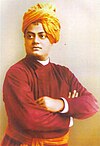Swami Vivekananda and meditation
On 24 December 1892, Vivekananda reached Kanyakumari and meditated for three days on a large rock and took the resolution to dedicate his life to serve humanity.He defined "meditation" as a state "when the mind has been trained to remain fixed on a certain internal or external location, there comes to it the power of flowing in an unbroken current, as it were, towards that point."[1] Meditation, which gives an insight to the depth and breadth of the mystical traditions of India, was developed by Ancient Hindu Sages.[7] Narendra wanted to experience Nirvikalpa Samadhi (the highest stage of meditation) and so requested Ramakrishna to help him to attain that state.One evening, when he was meditating with his friend Gopal (senior), he suddenly felt a light behind his head.We had no thought even as to whether the world existed or not.Between 1888 and 1893, Narendranath travelled all over India as a Parivrajaka Sadhu, a wandering monk, and visited many states and holy sites.During these lonely years, he reportedly gained inspiration from the words of Gautama Buddha—[12][13] Go forward without a path, Fearing nothing, caring for nothing![14][15] In 1893 Vivekananda travelled to the West and participated in the Parliament of the World's Religions, which was held in Chicago in that year.[20] He said "man-making" was his mission, and he felt for that we needed a composite culture of knowledge, work, love and meditated mind.[24] He defined Dhyana meditation as—[25] When the mind has been trained to remain fixed on a certain internal or external location, there comes to it the power of flowing in an unbroken current, as it were, towards that point.This whole process of divine meditation can only be initiated by an enlightened master who himself have seen God and can make you see that right at the time of Deeksha.

MeditationSwami VivekanandaRamakrishnaKanyakumariKanyakumari resolve of 1892CalcuttaCossiporeBaranagarGautama Buddhapeepul treeHimalayasParliament of the World's ReligionsChicagoDhyanaRaja YogaKurma PuranaRamakrishna Mission Institute of CultureBirthplacePrayer to Kali at DakshineswarBaranagar MathSwami Vivekananda's travels in India (1888–1893)Sarada DeviRelationship with Ramakrishnaat the Parliament of the World's Religions (1893)in CaliforniaTeachings and philosophyVivekananda and meditationInfluence and legacy of VivekanandaNeo-VedantaBibliographySangeet KalpataruBartaman BharatInspired TalksJnana YogaKarma YogaLectures from Colombo to AlmoraMy MasterThe East and the West"Kali the Mother"Khandana Bhava–BandhanaMy Play is DoneThe Hymn of SamadhiThe Song of the SannyasinTo the Fourth of JulyNachuk Tahate ShyamaBuddhism, the Fulfilment of HinduismChrist, the MessengerReligion not the crying need of IndiaArise, awake, and stop not till the goal is reachedAtmano mokshartham jagat hitaya chaBahujana sukhaya bahujana hitaya chaAdvaita AshramaBelur MathRamakrishna MathRamakrishna Math, MangaluruRamakrishna MissionUdbodhanVedanta SocietyNew YorkShuddhanandaVirajanandaSwarupanandaParamanandaAjit Singh of KhetriAlasinga PerumalHaridas Viharidas DesaiEmma CalvéJ. J. GoodwinJohn Henry WrightJosephine MacLeodSara Chapman BullSister ChristineSister NiveditaAbhayanandaWilliam HastieVivekananda Rock MemorialNational Youth Day (India)Swami Vivekananda AirportSwami Vivekananda Road metro stationSwami Vivekanand NagarVivekanandar IllamVivekananda SetuSwami Vivekananda statue (Golpark, Kolkata)150th birth anniversary of Swami VivekanandaSwami Vivekananda Youth Employment WeekVivek ExpressBireswar VivekanandaSwamijiBireswarChhattisgarh Swami Vivekanand Technical UniversityRamakrishna Mission Vivekananda UniversityRamakrishna Mission Vivekananda Centenary CollegeSwami Vivekanand Subharti UniversitySwami Vivekanand University, Madhya PradeshVivekananda Degree College, KukatpallyVivekananda Degree College, PutturVivekananda Global UniversityVivekananda InstitutionVivekananda Kendra VidyalayaVivekananda Vidya MandirSwami Vivekananda on HimselfLife and Philosophy of Swami VivekanandaNotes of Some Wanderings with the Swami VivekanandaPransakha VivekanandaRousing Call to Hindu NationThe Master as I Saw HimSankari Prasad BasuMani Shankar MukherjeeMarie Louise Burke